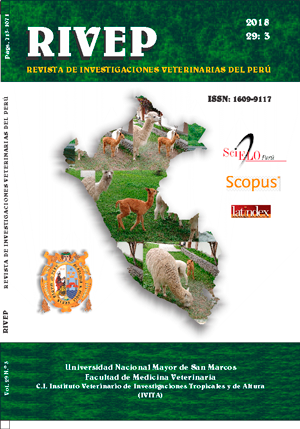Alpaca cheese: a new alternative
DOI:
https://doi.org/10.15381/rivep.v29i3.14015Keywords:
milk, alpaca milk, cheese, alpaca cheese, cheese yieldAbstract
The objective of this study was to evaluate the possibility of making cheese from alpaca milk. The physicochemical properties of the milk were determined, as well as the yield, chemical composition, and sensorial characteristics of the cheese. Milk was obtained by manual milking of alpacas at the beginning of lactation with crias at foot, set aside 12 hours before milking. The density, Dornic acidity and Gerber fat were determined, and total and non-fat milk solids were estimated in the milk. The chemical composition of the cheese was determined by official methods of the AOAC, and the sensory characteristics of the cheese through the hedonic test on a scale of 1 to 4 with 100 panelists. Fresh milk had a density of 1.0469 ± 0.0025, acidity 16.92 ± 1.74 °D, fat 4.12 ± 0.08%, protein 6.34 ± 0.41%, total solids 16.84 ± 0.70%, solids non-fat 12.72 ± 0.63% and a cheese yield of 21.6 ± 1.9%. The chemical composition of the cheese indicated 46.5% humidity, 18.9% ash, 41.8% protein, and 24.4% fat (dry matter). The cheese was a lean product with a hard texture and pleasant for consumption.Downloads
Downloads
Additional Files
Published
Issue
Section
License
Copyright (c) 2018 Heinz Howard Larico Medina, Eliseo Pelagio Fernández Ruelas, Yésica Rodrigo Vargas, Pedro Percy Machaca Ticona, Bernardo Roque Huanca, Heber Nehemias Chui Betancur, Regina Sumari Machaca, Ceferino Uberto Olarte Daza

This work is licensed under a Creative Commons Attribution-NonCommercial-ShareAlike 4.0 International License.
AUTHORS RETAIN THEIR RIGHTS:
a. Authors retain their trade mark rights and patent, and also on any process or procedure described in the article.
b. Authors retain their right to share, copy, distribute, perform and publicly communicate their article (eg, to place their article in an institutional repository or publish it in a book), with an acknowledgment of its initial publication in the Revista de Investigaciones Veterinarias del Perú (RIVEP).
c. Authors retain theirs right to make a subsequent publication of their work, to use the article or any part thereof (eg a compilation of his papers, lecture notes, thesis, or a book), always indicating the source of publication (the originator of the work, journal, volume, number and date).



